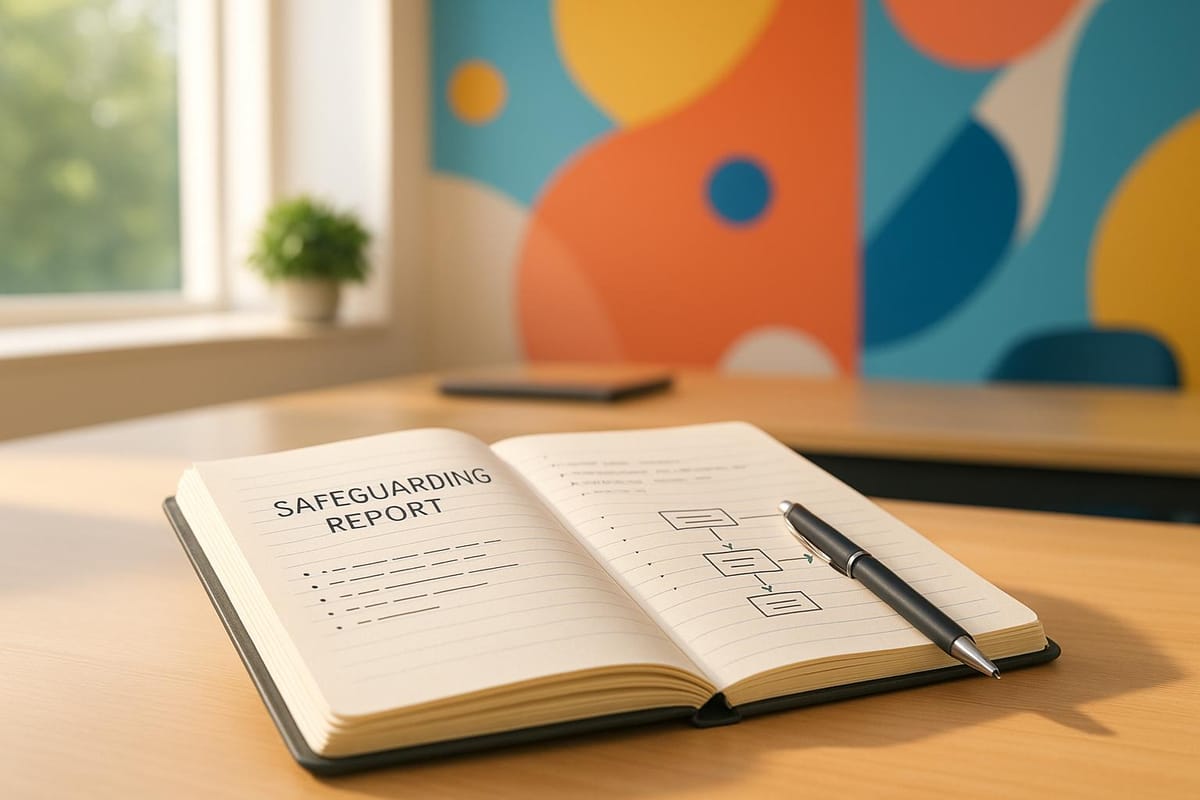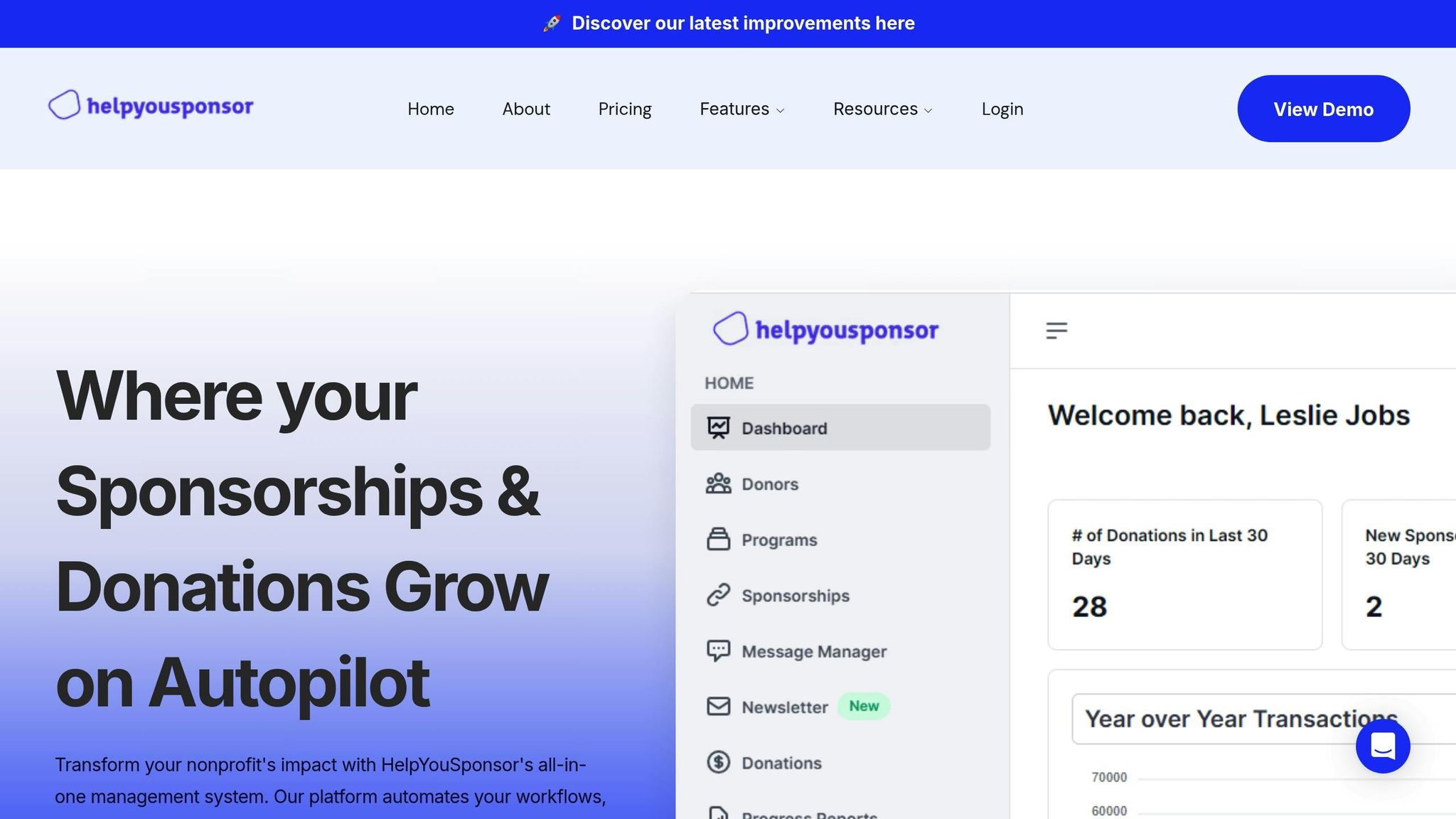How to Write Objective Safeguarding Reports
Learn how to write objective safeguarding reports that protect vulnerable individuals and ensure compliance with legal standards.

Safeguarding reports are critical for protecting vulnerable individuals, ensuring accurate documentation, and meeting legal requirements. Writing these reports objectively helps avoid bias, supports legal processes, and ensures fairness in decision-making. Here's what you need to know:
- Purpose: Safeguarding reports document incidents, concerns, and actions to protect individuals and ensure accountability.
- Objectivity: Focus on facts, avoid opinions, and clearly separate professional judgments.
- Legal Compliance: Follow federal and state laws, like mandated reporting requirements, to avoid legal risks.
- Clarity: Use simple, precise language, organize reports chronologically, and include specific details like dates, times, and evidence.
- Accessibility: Ensure reports are readable for all stakeholders, including those using assistive technology.
- Digital Tools: Platforms like HelpYouSponsor improve security, collaboration, and compliance while reducing errors.
Key Takeaway: Write safeguarding reports that are factual, clear, and legally compliant to protect vulnerable individuals and support informed decisions.
Safeguarding Report Basics
Report Purpose and Scope
Safeguarding reports play a critical role in documenting incidents, concerns, and responses to protect children and vulnerable adults while holding organizations accountable. These reports aim to create a secure environment for children by ensuring all incidents are properly recorded and addressed.
Typically, safeguarding reports focus on three key areas of responsibility:
- Incident Prevention: They document incidents, suspicious behaviors, or potential hazards to identify and mitigate risks.
- Regulatory Compliance: Proper documentation ensures that legal reporting requirements are met.
- Organizational Accountability: They establish a clear record of actions taken in response to safeguarding concerns, fostering transparency.
The scope of these reports includes all interactions involving staff, volunteers, and partners within an organization’s operations and programs.
With these objectives in mind, it’s essential to understand the legal framework that governs safeguarding reports.
U.S. Legal Requirements
Federal and state laws outline strict rules for documenting and reporting safeguarding incidents. Mandated reporting laws require specific professionals - such as social workers, teachers, healthcare providers, childcare workers, and law enforcement officers - to report suspected child abuse or neglect[4]. Ignoring these obligations can lead to severe legal consequences. For example, under 18 U.S. Code § 1169, failing to report child abuse in Indian country can result in fines or imprisonment.
In Iowa, mandated reporters are required to make an oral report of suspected abuse within 24 hours, emphasizing the importance of timely documentation. Furthermore, legal protections are in place for those who report in good faith. Individuals acting on a reasonable belief are shielded from civil and criminal liability. Iowa law also protects reporters from employer interference when filing abuse reports.
Many states utilize central registries for tracking child abuse and neglect reports. These systems help identify patterns and guide future protective actions. States such as Alabama, Florida, Georgia, Idaho, Illinois, Indiana, Maine, Mississippi, Nebraska, and Nevada maintain these registries[4].
Organizations must align their internal policies with federal and state guidelines. For instance, the Iowa Department of Health and Human Services advises employers to provide clear guidance on mandatory reporting procedures and ensure staff understand both their legal responsibilities and organizational expectations.
Beyond meeting legal obligations, ensuring reports are clear and accessible is essential for effective safeguarding.
Writing Clear, Accessible Reports
To meet both legal and organizational standards, safeguarding reports must be clear and easy to use for all stakeholders, regardless of their technical expertise.
Navigation is a priority. Reports should include a clickable table of contents and consistent heading structures (H1, H2, H3) to help readers locate information quickly. This structured format allows busy professionals to access critical details without wading through lengthy documents.
Language should be simple and direct. Using plain English, accessible fonts like Arial or Verdana, and maintaining high contrast between text and background ensures readability for a wide audience.
Accessibility is not just a best practice - it’s also a legal requirement. In 2023, over 4,600 ADA lawsuits were filed in the U.S.. Additionally, 67% of assistive technology users reported encountering inaccessible documents that impacted their work or daily life.
To accommodate assistive technology users, reports should include proper tagging and labeling. This means adding alt text for images, charts, and graphs, and using descriptive link text that clearly explains its purpose or destination. For example, one bank discovered that its most-downloaded form was completely inaccessible to screen readers, creating significant challenges for thousands of users.
Finally, reports should guide readers through incident details, actions taken, and outcomes in a logical order. Using section breaks and preset styles in document creation software enhances consistency and improves navigation for those relying on assistive technology. A well-organized report ensures that all users, regardless of their abilities, can access and understand critical safeguarding information.
Collecting and Organizing Information
How to Collect Accurate Data
Creating effective safeguarding reports starts with having clear objectives and gathering complete, unbiased data. This ensures your focus remains on the most critical issues and aligns with your organization's safeguarding priorities.
To document incidents effectively, use a mix of direct interviews, observations, and structured questionnaires. Direct interviews provide firsthand accounts of events, while observations let you capture behaviors and environmental factors. Structured questionnaires and official forms help maintain consistency across different incidents and reporters.
Establish clear protocols and train your team to ensure the data you collect is reliable. Before including any information in your report, assess its credibility by validating sources, cross-referencing details, and separating firsthand observations from hearsay.
Keep a detailed audit trail throughout the process. This means recording the sources you consult, documenting search queries, and noting the timestamps for when you retrieve information. This level of detail not only strengthens the reliability of your findings but also supports legal documentation requirements.
Physical evidence is just as important. Preserve items like photographs of injuries, damaged property, or environmental hazards that played a role in the incident.
Ethics should guide every step of your data collection. Always obtain informed consent from interviewees, protect their confidentiality, and be transparent about your methods and goals. Avoid leading questions or any approach that could introduce bias into your findings.
Once your data has been validated, organize it into a structured report that is clear and actionable.
Structuring Information for Clarity
A well-organized report turns raw data into meaningful insights that can help safeguard vulnerable individuals. Systematic documentation ensures your report is thorough and consistent, making it easier to follow and ensuring no critical detail is missed.
To create a logical flow, use clear sections, headings, and subheadings. Begin with the incident details, then outline the chronological events, and finish with the actions taken and their outcomes. This structure mirrors how investigators and administrators typically process safeguarding information.
Visual organization plays a key role in readability. Use headings, bullet points, and subheadings wisely to break up dense text and highlight essential information. Be careful not to overuse these tools, as too much formatting can overwhelm the reader.
Tailor your report's structure to the needs of its audience. For instance, child protection services, law enforcement, and organizational leaders may each approach safeguarding reports differently. Consider how your report will be used and organize it accordingly.
Consistent categorization is also essential. Develop a standard way to classify information, such as public, internal, confidential, or highly confidential. This ensures sensitive details are protected while allowing relevant information to flow where it’s needed.
For incident documentation, a chronological approach often works best. Present events in the order they occurred, using timestamps when available. This timeline helps readers understand how the situation unfolded and what steps were taken to address it.
Paper vs. Electronic Documentation
After organizing your data, decide whether to use paper or electronic documentation. This choice impacts the accuracy, accessibility, and long-term usefulness of your report.
Electronic documentation offers significant advantages for maintaining data quality and accessibility. Digital systems can perform automated validation checks, enforce consistent data entry formats, and support regular data cleaning. They also provide features like role-based access controls, audit logs, and secure storage with reliable backup systems.
For example, Walmart demonstrates the efficiency of electronic validation systems. Their inventory management uses data checks to ensure items meet specific criteria for type, quantity, and storage location, reducing errors and improving accuracy.
Technology integration simplifies the documentation process. Field staff can use mobile forms to document incidents immediately, while online platforms allow teams to collaborate in real-time. These systems can also automatically organize data, generate reports, and ensure compliance with data protection regulations.
However, paper documentation still has its place. Physical forms don’t require technology, making them reliable during emergencies. They also provide an intuitive option for staff who aren’t comfortable with digital systems.
| Aspect | Paper Documentation | Electronic Documentation |
|---|---|---|
| Accessibility | Works without technology; immediate access | Requires devices and internet; searchable databases |
| Data Integrity | Prone to loss, damage, and transcription errors | Automated validation, backup systems, version control |
| Compliance | Manual tracking of retention periods | Automated compliance monitoring and audit trails |
| Collaboration | Physical sharing limitations | Real-time collaboration and instant updates |
| Cost | Lower initial setup costs | Higher setup costs but reduced long-term expenses |
| Security | Risks include loss and limited control | Encryption, role-based access, detailed audit logs |
The shift toward electronic systems reflects their ability to maintain data quality over time. Poor data quality costs U.S. companies $3.1 trillion annually, and 60% of businesses report that data integrity issues negatively impact their analytics outcomes.
How to Write a Report | Essential Reporting Skills for Security Professionals | Security Skills
Writing Objective and Accurate Reports
Once you've organized your information, the next step in creating effective safeguarding reports is ensuring objectivity. This means presenting details that are both accurate and professionally written. Your report should clearly communicate safeguarding concerns to decision-makers. Below, we’ll explore how to separate facts from opinions, use precise language, and back up your observations with evidence.
Separating Facts from Opinions
A strong safeguarding report makes a clear distinction between facts, opinions, and professional judgments. Facts are based on direct observation and can be verified, while opinions are personal viewpoints that should not influence what is recorded. For instance, instead of saying, "The child seemed upset" (an opinion), describe exactly what you observed: "The child was crying, had red, swollen eyes, and spoke quietly when asked questions."
Judgments, which are conclusions drawn from professional experience, must be clearly labeled as such. For example, you might say, "In my professional opinion, the child appeared fearful of their caregiver." Additionally, when including information from third parties, always cite the source to clarify its reliability - such as, "According to the teacher, Maria Johnson." This ensures transparency and helps readers gauge the credibility of the information.
Using Precise, Objective Language
The language you use in safeguarding reports should be clear, specific, and factual. Avoid vague descriptions and instead provide concrete details. For example, rather than stating, "The home was messy", describe what you saw: "Dishes with food residue were stacked on the kitchen counter, clothing was scattered across the living room, and the bathroom had no toilet paper or soap."
Steer clear of speculation or personal opinions. If you need to include professional judgments, explicitly frame them with phrases like "based on my experience" or "in my professional opinion." Reports should also follow a chronological format, including specific timestamps when possible. For instance, "At 2:15 PM on March 15, 2025, I observed…" This approach not only adds clarity but also makes it easier for others to verify the sequence of events. By using precise language and supporting your observations with timestamps, your report becomes more reliable and credible.
Including Supporting Evidence
Evidence is a cornerstone of effective safeguarding reports. To provide a well-rounded account, gather as much relevant information as possible. This includes details about the individual involved - like their name, age, and any specific needs or vulnerabilities - to help contextualize the situation. Include critical data such as dates, times, locations, and recurring patterns in behavior or incidents. This level of detail allows investigators to follow up with witnesses and validate your observations.
Collect and organize related documentation, such as previous reports, medical records, photographs, or witness statements. Ensure these materials are securely stored and easily accessible. For physical evidence, take extra precautions: photograph injuries, property damage, or environmental hazards, and document the chain of custody to maintain credibility. When recording observations, focus strictly on what you see, not on assumptions or feelings. Even small details - like a person’s demeanor, clothing, or what they were eating - can provide valuable context. If you notice any gaps in your evidence, take steps to fill them to ensure your report is as thorough as possible .
Digital Tools for Safeguarding Documentation
Clear and reliable documentation is the backbone of effective safeguarding practices, and digital tools have taken this to the next level. By replacing outdated paper-based methods, these tools bring improved security, easier access, and better compliance standards. They help reduce mistakes, standardize reporting, and centralize data, making it easier for organizations - especially nonprofits handling sensitive information about vulnerable individuals - to maintain accuracy and consistency in their safeguarding efforts.
Organizations using digital platforms have reported noticeable improvements in tracking incidents, staying compliant, and responding more quickly to safeguarding concerns.
Using HelpYouSponsor for Safeguarding Reports

HelpYouSponsor offers a secure, centralized platform tailored for managing safeguarding documentation and donor-related activities. With robust security measures, it ensures compliance with U.S. data protection laws, making it an ideal solution for handling sensitive information.
One of its standout features is role-based access controls, which limit who can view or modify safeguarding reports. This is particularly crucial for nonprofits working with vulnerable populations, where confidentiality is non-negotiable. By assigning specific permissions to staff, the platform minimizes the risk of unauthorized access to critical documentation.
HelpYouSponsor also includes an integrated messaging system that allows team members to communicate securely about safeguarding concerns. These conversations are automatically logged, creating an audit trail for every discussion related to safeguarding incidents.
The platform enables organizations to maintain detailed records of safeguarding concerns, track the progress of investigations, and document activities in chronological order. For nonprofits managing multiple programs or locations, HelpYouSponsor’s unified dashboard provides a clear overview of all safeguarding efforts. This makes it easier for administrators to spot patterns, monitor response times, and ensure that protocols are consistently followed.
By incorporating these features, HelpYouSponsor strengthens an organization’s overall safeguarding practices and ensures high-quality reporting.
How Digital Platforms Improve Report Quality
Digital platforms bring significant improvements to report quality by standardizing data entry and enabling real-time collaboration . Automation plays a key role here, offering templates, mandatory fields, and validation checks that reduce errors and ensure all necessary details are included. Centralized data storage provides a complete view of an individual’s history, allowing staff to quickly review past incidents, spot trends, and make better-informed decisions.
Collaboration becomes much more efficient, as multiple authorized users can contribute to a single report, add updates, or provide context - all without compromising the original information.
Real-time monitoring and alert systems further enhance safeguarding efforts by notifying supervisors immediately when high-priority incidents are reported. Additionally, data analytics tools help organizations identify trends and proactively address recurring issues.
Security is another critical advantage. Features like encryption, regular audits, and compliance with standards such as SOC II and ISO 27001 protect sensitive information. Considering that 88% of data breaches are caused by internal errors, these automated safeguards are essential.
Beyond improving report quality, digital safeguarding tools deliver financial benefits. Organizations using compliance technology report average savings of $1.02 million, thanks to reduced administrative costs, quicker incident resolution, and better regulatory compliance. These savings, combined with the enhanced protection of vulnerable individuals, highlight the importance of integrating digital platforms into nonprofit safeguarding efforts. By ensuring standardized and objective reporting, these tools reinforce a commitment to fairness and accuracy in safeguarding.
Key Points for Objective Safeguarding Reports
When crafting safeguarding reports, it's crucial to focus on accuracy, neutrality, and legal compliance. These principles ensure the reports are clear, actionable, and legally sound. Here's how to achieve that:
The backbone of a strong safeguarding report is strict objectivity. Research highlights that 34% of digital forensic practitioners fail to employ techniques that preserve objectivity, which underscores the importance of this practice. Using factual language is non-negotiable - your statements must be based on observable facts. Document what you directly witnessed, heard, or verified through physical evidence. If you need to include opinions or assessments, make sure they are clearly labeled and kept separate from the factual account.
Organizing the report in chronological order brings clarity to the sequence of events. Include precise details such as dates, times, locations, and the names of everyone involved, including witnesses. This structure helps decision-makers fully grasp the situation and make informed judgments.
To avoid bias, consider multiple hypotheses when analyzing incidents. A study found that 45% of digital forensic practitioners begin their work without exploring alternative explanations, which can lead to incomplete conclusions. By systematically testing alternative hypotheses against the evidence, you can ensure a balanced and thorough report. Any conclusions drawn should be firmly supported by the evidence.
Supporting your observations with additional evidence, such as photographs or witness statements, strengthens the credibility of the report. This approach not only protects the individuals involved but also shields your organization from potential legal challenges.
Confidentiality is another cornerstone of safeguarding reports. Share sensitive information only with authorized personnel, and keep detailed logs to track who accesses the documentation. Secure storage of reports is essential to maintain trust and compliance with data protection regulations.
To minimize errors, implement a review process where multiple qualified individuals examine the report before submission. This collaborative step can catch biases or oversights that a single author might miss, enhancing the overall quality and reliability of the documentation.
A robust compliance framework ensures that reports align with legal and regulatory standards. Include sections that reference relevant legislation, document staff training, and highlight adherence to organizational policies. If staff members require additional support or training, note these areas for improvement.
Finally, include actionable recommendations to address the concerns raised in the report. Specify who is responsible for each action, set clear timelines, and define measurable outcomes. This turns the report into a practical tool for resolving issues.
To maintain the relevance and effectiveness of safeguarding reports, establish systems for ongoing monitoring. Regularly track action plans and updates to ensure the report evolves as circumstances change. This continuous oversight keeps the documentation accurate and impactful.
FAQs
What are the best practices for writing an objective safeguarding report?
To create an objective safeguarding report, center your writing on facts and evidence, steering clear of personal opinions or assumptions. Keep the language neutral and avoid emotional phrasing. Your goal is to present information that is clear, precise, and based solely on what has been observed or reported - without adding personal interpretations.
When conducting interviews, rely on neutral, open-ended questions to ensure responses are not influenced. Wherever possible, verify the details you gather with reliable evidence to maintain accuracy. It's also crucial to stay aware of any unconscious biases and work to keep your perspective fair and impartial throughout the reporting process.
How can tools like HelpYouSponsor improve the accuracy of safeguarding reports?
Digital tools such as HelpYouSponsor make it easier to create precise safeguarding reports. By automating the way data is collected and managing incidents in a centralized system, these tools reduce the chances of human error while ensuring consistent and reliable documentation.
They also help organizations stay compliant by aligning with regulatory requirements and offering real-time monitoring features. This combination not only strengthens the accuracy of reports but also saves time, allowing organizations to dedicate more energy to their primary objectives.
What key legal factors should be considered when documenting safeguarding incidents in the U.S.?
When documenting safeguarding incidents in the U.S., accuracy and objectivity are key. Make sure to include all relevant details like the date, time, people involved, and a clear timeline of events. Stick to the facts - avoid adding personal opinions or assumptions to ensure the report remains unbiased.
It’s also important for organizations to follow legal requirements, such as HIPAA, when dealing with sensitive health information. To maintain confidentiality, safeguarding reports should be securely stored. Proper documentation isn’t just about meeting legal obligations - it also plays a critical role in managing risks and supporting any legal actions that might arise.

